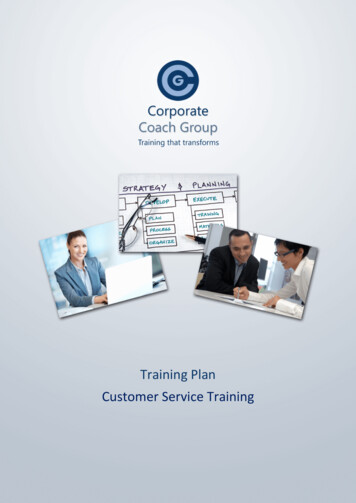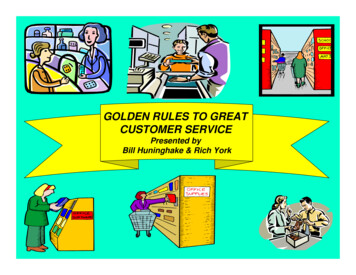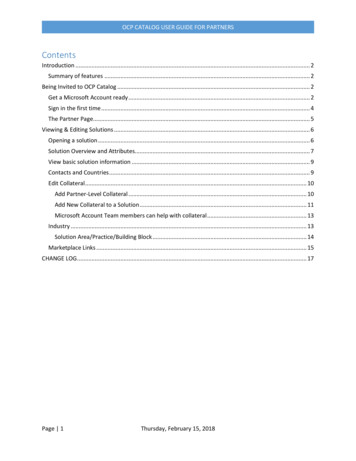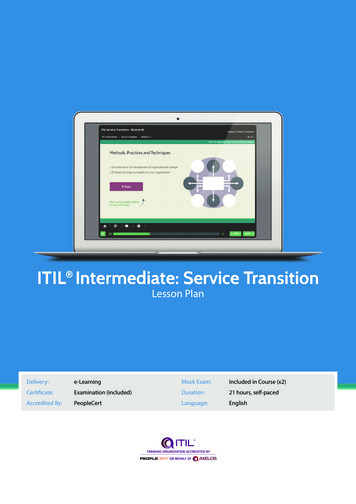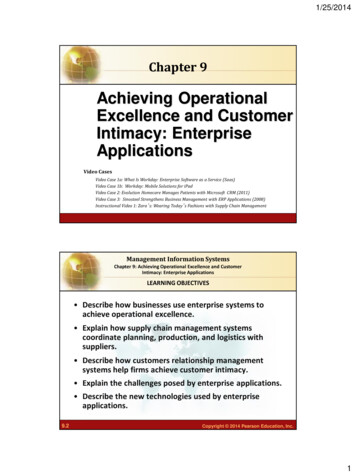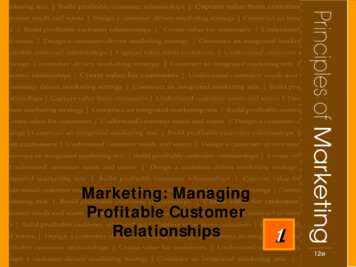
Transcription
CUSTOMER SERVICEHANDBOOK Hans G. PfaffA handbook for your communityNunavut Tourism1Customer Service Handbook
2Customer Service Handbook Christian KimberNunavut Tourism
Table of Contents4Introduction6For the Owner, Manager and Supervisor7Creating Good Customer Service Standards9Elements of a Good Training Program10Customer Service Standards - Communications13Customer Service Standards - Housekeeping14Customer Service Standards Restaurant/Dining Room16Customer Service Tips - For outiftters17The Hallmark of Hospitality19General Dos and Don’ts of Hospitality20How well do you know your community?21What to do when a customer complains?22ConclusionNunavut Tourism3Customer Service Handbook
IntroductionThe person on the receiving end of yourcompany’s product and service is often re ferredto as “customer,” “guest,” “client,” “tourist,”and “visitor.” One thing is certain; these peopleare looking for a quality expe rience from thebeginning. In fact, they are expecting it! Iftheir expectations are not met, they becomedisappointed and often take their businesselsewhere. So we can clearly see that qualitydoes have value.Quality is a process. There are performance standards that must bein place. These must be communicated and implemented at all levelsin the establishment. They require leadership from the manager orowner. These customer service standards need to be monitored,reviewed, and updated regularly.Customer expectation must be recognized and acted upon.Ask yourself if your defini tion of quality is the same as what thecustomer expects. Our customers are edu cated, perceptive anddemanding. When they make a reservation, order a meal, book aguided trip, or check into a room, they have certain expectations.You must iden tify whether you are falling short, meeting orexceeding their expectation of quality.Your success is built on howwell you deliver!This customer service handbook attempts to provide tips, populardos and don’ts, helpful hints, and checklists as well as provenbest practices in a customer setting. It addresses the view frommanagement, staff and the customer and their role in the chain ofthe Quality Service Experience.Nunavut Tourism4Customer Service Handbook
A Customer is:uuThemost important person we do business withuuNotdependant on us; rather we on him/her fortheir businessuuNotan interruption of our work but the purpose for ituuAperson who expects satisfaction and value formoney spentuuAneducated consumer who is aware of yourcompetitionuuAperson who should be treated with respect andcared for to the best of your ability, no matter whothey areuuAperson to build a future withuuAsource of information to help improve our businessuuApleasure to serveopportunity, not an impositionuuHandledelicate situations with common sense.uuBesensitive to special needs.uuBean honest person.uuTakeresponsibility for both good and bad service.uuTreatall customers equally.Nunavut Tourism5Customer Service Handbook Fritz MuelleruuAn
For the Owner, Manager and SupervisorTwo of the biggest downfalls of customer service training are thatthe subject is either swept under the “welcome mat” or it is treatedas a special training event only.Hospitality operations are particularly aware of the challenges. Dueto the nature and diversity of most operations, and other factorssuch as budget and time constraints, there just never seems to beany time or money allocated for this purpose.The importance of creating successful cus tomer service standardscannot be over emphasized and relies upon the initial implementationof the ideology. Training is crucial, and perhaps the most difficultstep is maintaining and monitoring the customer service processand results. Lee NarrawayNunavut Tourism6Customer Service Handbook
Creating GoodCustomer Service StandardsTwelve Keys to Developing Good Customer Service01Start at the topManagement and ownership not only have to ensure thatthe service ideology is reflected in the mission statement,but they must first and foremost lead by example andbe visible on a daily basis. Their words and actions mustcorrespond accordingly that the line staff can modelimplementation based on their clear example.02Measure FirstBefore embarking on a major customer service safari,assess your current service level and identify what needsattention and improvement. Traditional data such ascustomer letters, complaints, feedback and surveys aretools to get you started. Don’t forget to approach your staffbecause they have firsthand experience in the matter.03Make training and skill buildingpart of your strategic planGoals related to customer service need to be afoundational component of short and long-term strategy.They are usually set out as core values in missionstatements and make their way to the training floor. Makeservice a priority in your business.04Train management and make them accountableSince most managers work in a customer serviceenvironment and are involved in the day-to-day, hands-onscheme of things, they play a critical role in the servicechallenge and are responsible for providing leadership.Managers must be of the mind and skill set to deliver this,and also be present and visible during peak service activityto support the process.05Choose the right programWhether you design your own, or adopt and outsideprovider, a training program meant to improve your serviceshould include proven standards.Nunavut Tourism7Customer Service Handbook
0607LaunchGet behind it from the beginning and make it an excitingpriority. An effective launch will probably fail!08Identify your barriers to excellent serviceduring trainingWhen staff and management go through a trainingprocess, participation and spirited discussion will occur.Issues will arise that will not be resolved during thetraining. Staff are not shy in giving their feedback onceencouraged to do so.To properly ad dress these issues,keep a record of the com ments on a flipchart or blackboardas they come up so that staff can see that their views arebeing considered for evaluation.09Measure ResultsUsually, improvements will be observed im mediatelyfollowing the training. Your em ployees and the workenvironment should appear more positive. The true testof re sults is the level of staying power of the changesimplemented.10Create a Process Improvement TeamAcquire a volunteer or assign a staff mem ber to handle thefollow-up of issues ad dressed in the training. Managementwill work with these team members on the day to-dayservice monitoring also.11Include Customer Service Trainingin the new employee orientationEquip and empower new employees with the skills andvalues reflected in the training program. By establishingthem from the start you align them with other trained staffand clearly indicate to them what your ex pectations are.12Reward and RecognitionAcknowledge your returns on a daily basis. Staff want anddeserve to know that they are doing well and also thatthey are wor thy of your investment in their training.Deliver Quality not QuantityFacilitation is paramount. You may or may not havesomeone on staff that is trained or capable of leading thetraining. A boring, rambling or insincere lecture will be ofno value.Nunavut Tourism8Customer Service Handbook
Elements of a Good Training ProgramWhether you design your own or adopt a proven outsideprovider, a training program meant to improve your servicestandards should include some of the following characteristics:uuBehaviorchanging activitiesuuServicestandards that are customized for your ownorganization and work environmentuuSpecificmodules for managers that may include leadership,standards development, etc.uuInteractiveand guuRelevantcomparisons to the current service experiencePresentation: What you say is important. How you say it isequally as important.A strong presentation usually contains the following:uuDynamicstart and throughoutuuAnimated,enthusiastic presentationuuLeadershipuuPassionsskillsfor excellent serviceuuKnowledgeof organization’s utgroup activityNunavut Tourism9Customer Service Handbook
Customer Service Standardsu CommunicationThe following are good tips that help pro vide acceptable servicelevels in the area of telephone/voice mail and inquiry manage ment. They pertain to any small business as well as home-basedoperations.Voice Mail/TelephoneTelephones should be answered as promptly as possible. Try to set aspecific number of rings, and make it your goal to answer before the4th ring, for example.All employees or family members should be trained to answer thephone properly. If there are children answering the business phone,they should be able to give the mini mum key information.Answer all calls in a courteous manner. A scripted consistentgreeting works well and sounds professional. An example would be,“Good morning, Iceberg Outfitters. Joe speaking. How can I helpyou?’During business hours, a person should be answering the mainnumber instead of hav ing voice mail or an automated message.Staff should listen, understand, and ac knowledge the nature of therequest before transferring any calls.Where possible, give the client the option to go to voice mail orleave a message ver bally.All staff and management should adhere to a policy that setstimelines to returning calls and responding to enquiries. Same day isrecommended.AII outgoing voice mail (recorded greeting) messages should bebrief, current and accurate. An example would be: “Hello, You havereached Joe at Iceberg Outfitters. I’m out of the office until Oct 1st.Please leave a message and I will return your call”A good outgoing voice mail message will contain the person’s name,department, telephone numbers and time available.Nunavut Tourism10Customer Service Handbook
Outgoing voicemail messages should have an optional numberor extension to call for urgent enquiries. This could be especiallyimportant in the case of relatives trying to contact guests of a hotel,or someone who wants to purchase your services immediately.Learn how to prioritize your daily messages and enquiries. Answerthe most important ones first.If a caller is on hold, be aware of the length of time and set astandard for this. It is acceptable to take that person’s number andcall him back if you are multi-tasking at that time. Christian KimberWhen leaving town or being away from your business, change yourvoicemail to provide that information so that your potential clientsare informed.Nunavut Tourism11Customer Service Handbook
Written Correspondence - Letters, E-Mails, FaxesThe exchange of information comes in many forms. To respondaccurately and timely is key. The inconvenience of repeat ing or resending information or unreason able waiting time can be interpretedas poor service.Any written communication should be re viewed before you send itout by email, fax or mail. To send incomplete or incorrect in formationcauses delays and could cost you time and money.All responses should be timely. For e-mails, within 24 hours isacceptable but the same day is best. For regular mail, within fivebusiness days is good.All correspondence should contain a “signature block” that includescompany name, person’s name, complete address, telephonenumber, fax number and e-mail address.In PersonMake your first impression a positive one.A timely, courteous acknowledgment in cluding eye contact gives agood first im pression, especially if the staff person is on the phoneor engaged with another client.If you are busy with a client and the phone rings, or something takesyou away from serving the client, excuse yourself and then addressthe new situation. To serve both clients efficiently - take a message,phone the person back or delegate the new en quiry to a co-workerand then return to the initial conversation with the first client.If a station is not staffed, such as the front desk of a hotel, have thehours posted at that station as to when a person will be there and/orleave instructions as to where the person could find immediate help.Nunavut Tourism12Customer Service Handbook
Customer Service Standardsu HousekeepingAlways a constant concern! Cleanliness and tidiness are firstforemost in the eye of the beholder. A customer’s first impression isalways visual.Building and Public AmenitiesProperly maintained facilities, which are sanitary, completelyoperational, fully stocked and supplied, accessible and meet healthand safety standards is a key element to your customer’s impressionof your ability to provide continuous good customer service. Hoursof operation, timely and accurately posted information such as roomdirection, menu specials, and special announcements, are alsogood indicators of a well-managed business. Good housekeepingcan be over-emphasized. Your standards for cleanliness reflect yourcommitment to showing your customers excellent service.Avoid the following inappropriate housekeeping situations in yourfood service areas:In the Restaurant'' Food Particles on the floor or on tables and chairs'' Unclean cutlery'' Dishes left on tables for too long'' Washrooms unattended'' Stained linen and napkins'' Dirty Floors'' Carpet Odour'' Cluttered and untidy workstations'' Stained and unclean glassware'' Stains on the wall'' Dust on the ceiling, lights and fans'' Dirty and food splattered menusNunavut Tourism13Customer Service Handbook
Customer Service Standardsu Restaurant/Dining RoomBelow are common problems and solutions to situations that occurin the food and bev erage environment.Speed of serviceDon’t be afraid to inform customers at your table if things are takinglonger than ex pected. They will appreciate being kept in formed onthe status of their order.Professional appearanceMake sure your uniform is clean and you are properly groomed. Yourappearance con tributes to the first impression the cus tomers makesabout your establishment. Chewing gum or eating in front of guestsis not professional.Quality checksPay attention to the body language and fa cial expressions of yourguests. You can tell if something is wrong right away. Visit thetable after you have delivered the meals as this will give you anopportunity to correct any problems before it is too late.MistakesIf you get the order mixed up, or something is incorrect with themeal, don’t be afraid to recognize the error and inform the guest thatyou will fix it immediately.Customer focusRather than gathering at the staff table or staff area in the diningroom, focus on making trips to your customers’ tables to be visibleand available to serve your cus tomers as needed.Nunavut Tourism14Customer Service Handbook
Appropriate discussionLimit your conversation with your coworkers to work-related subjectsand use professional language and a proper voice level. Guestsdo not want to hear the latest gossip or what’s going on in yourpersonal life.Hide your frustrationSometimes things can be hectic. When there are problems behindthe scenes, keep them quiet and don’t let your customers see yourfrustration.Workplace issuesIt is not appropriate to discuss work-related problems or issue withyour guests. Direct your concerns to the management or ownershipand give them the chance to solve your problem.Closing timeDon’t rush the guest but rather continue with your responsibilities.The guest can usually tell when it is time to finish up and paytheir bill.Nunavut Tourism15Customer Service Handbook Hans G. PfaffThese customer servicestandards need to be monitored,reviewed, and updated regularly.
Customer Service Tipsu for OutfittersGood customer relations can leave a lasting positive impressionthat leads to increased return business by word of mouth. Thefol lowing are ways to ensure customer satis faction and preventdisappointment:uuFollow-upon all enquiries and sales opportunities efficiently.uuAdvertiseonly what you can guarantee to deliver. Be realistic.uuInformclient of any changes to agree ment as soon as possible.uuConfirmall details of contract or service prior to start date. Thiswill prevent confusion and disappointment of something thatwas expected but not delivered.uuHavehandy checklists ready and refer to them prior to activityto eliminate over sights.uuDevelopa client information sheet that is complete withsuch things as names, ages, origin, language spoken,medical conditions, experience level, special needsand contact numbers.uuMakesure your communication system, schedule andequipment is failsafe and meets industry standards.uuBeon time.uuWelcomeuuBriefuuBeyour clients in a professional and confident manner.clients completely before activity starts.aware and follow all licensing and leg islative guidelines.uuShareknowledge in the areas of culture, history, land and otherpertinent informa tion as often as possible.Nunavut Tourism16Customer Service Handbook
The Hallmarks of HospitalityCustomer service is the pillar for success in almost every business.The relationship between the supplier, the product and theconsumer requires dedication to his ideal every step of the way.Include the following elements of customer service in your day-today interactions.AcknowledgementThis is the first step for creating respect and confidence betweenthe employee and the customer. It’s as simple as making eyecontact, smiling and taking time to speak to a guest. Whether inpassing, or directly dealing with the customer, this primary focusgoes a long way.RecognitionMake your customers feel welcome and important by rememberingtheir name, and referring to them in a professional and appropriatemanner.AnticipationImpress your guest by staying on top of their needs before they haveto ask you for them. Re-filling a water glass or offering a wake-upcall and taxi service the night before a person checks out are goodexamples of this in a hotel.FlexibilityBe prepared with alternative options to clients’ requests. Sometimesthinking outside the box is required to manage your customers’needs to solve problems.KnowledgeBoth employee and employer should make sure that they have theinformation required to complete the goals of the job. Missing piecesof the puzzle can cause delays and other problems contributing to aninferior service experience.Nunavut Tourism17Customer Service Handbook
SkillsAlong with knowledge, skills are developed through training, thenmonitored and utilized in the ongoing customer service process.ListeningHave a “guest first” focus. Give your customers your total attentionto make them feel valued.RecoveryNunavut Tourism18 Lee NarrawayMistakes are bound to occur; how you deal with them is important.Empower and train staff to handle negative situations. Rememberthat the worst of situations can have a positive outcome if handledproperly.Customer Service Handbook
General Dos and Don’ts of HospitalityThe busy work environment of a customer service setting can bestressful. We are always under the watchful eye of our boss, coworkers and most importantly, our customers. Sometimes we arenot aware of our own behaviour or what we look and sound likewhen working.Dos:&& Do make sure you are presentable and meet the uniformstandards of your company.&& Do come to work with a positive attitude.&& Do prepare your work area. Set yourself up for success.&& Do your job to the best of your ability.&& Do respect your co-workers. Be a team player.&& Do act professionally at all times.&& Do call in when you are going to be late or sick.&& Do make your guest feel welcome. Greet them pleasantly&& and treat them with respect.&& Do have a general knowledge of your community.&& Do know where to find answers to questions if you&& don’t know them.&& Do check the washrooms regularly to make sure they are cleanand stocked.Don’ts:'' Don’t leave your work area without having someonelook after your customers.'' Don’t eat or drink while providing service to a customer.'' Don’t have friends visit you while you are working.'' Don’t lose your temper when things aren’t going smoothly.'' Don’t allow others to bring you down.Nunavut Tourism19Customer Service Handbook
?How well do you knowyour community?Both business travellers and tourists are often interested inspending some time learning about your community and its historyand culture. If you can answer these common questions withouthesitation, you will no doubt impress your customer.uuHowdid your town get its name?uuWhereuuDois the hamlet office?you have a Chamber of Commerce?uuWhatis the population of your community?uuWhereuuHoware the library, high school, and college?do I get to the clinic or hospital?uuWhatare the points of interest within walking distance?uuWhatrestaurants are available?uuWhatis the lunch/dinner special?uuWhatis in this menu item – re: allergies?uuWhataccommodations are available?uuHowdo I get a taxi?uuWhereuuWhatcan I find tourist information?time do you open and close?uuWhereis the post office?uuWherecan I find internet access?uuDoyou know any licensed outfitters?uuWhatuuAreis the weather forecast?flights delayed?Nunavut Tourism20Customer Service Handbook
?What to do whena customer complains?uuDon’tavoid the situation.uuHaveconfidence in your ability.uuAlwayskeep calm.uuAcknowledgeuuApologizeuuListenwhen appropriate.to the concern.uuEvaluateuuAskthe problem.the problem.how you can make it better for them.uuEvaluateuuExplainuuGivethe solution.how you will try to solve problem.a time frame as to when will it be fixed.uuOnceyou have fixed things, follow-up af- terwards.uuDon’tcomplicate the situation.uuBediplomatic and tactful.uuNeverplace blame.uuWhenyou can’t solve the problem, get help fromsomeone who can.Nunavut Tourism21Customer Service Handbook
ConclusionAnd the reward is uuYouget to meet new people in a customer service job setting.uuThepositive response you get from customers will give youconfidenceuuIt’ssomething to be proud of It’s fun to care about doing yourbest It will make your workplace a positive place to be atuuYougive the customer value for his moneyuuSomepositions receive tips from customers (extra money totake home with you at the end of the day)uuYouimpress your boss and show that you are an asset to thecompanyuuSometimesyou can make an impression that will affectyou in the future such as new opportunities and/or careeradvancementuuYouset an example for your co-workers, and are admired foryour efforts.uuYouhelp create high standards for the companyuuyoucontribute to an overall memorable experiencefor the customeruuYouhelp give the company, the community and the territory agood reputation for customer service.Your success is built on howwell you deliver!Nunavut Tourism22Customer Service Handbook
customer expects. Our customers are educated, perceptive and demanding. When they make a reservation, order a meal, book a guided trip, or check into a room, they have certain expectations. You must identify whether you are falling
